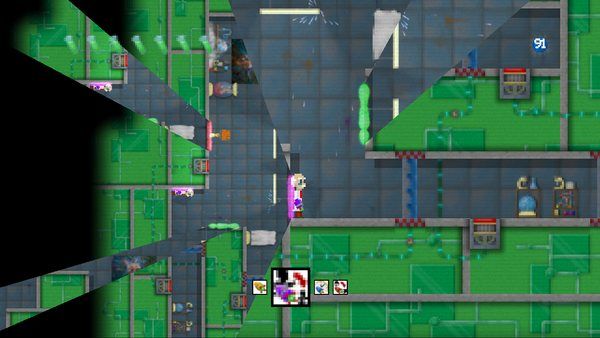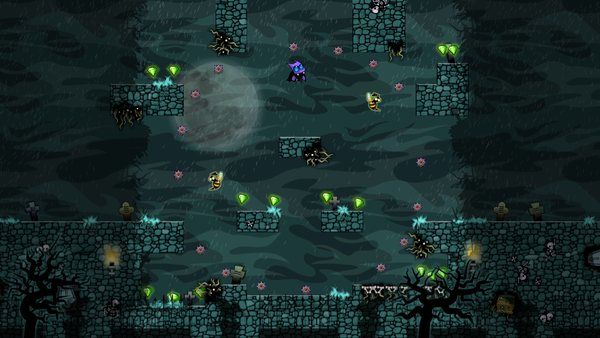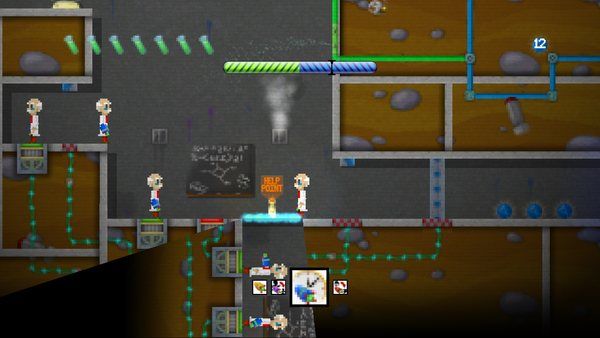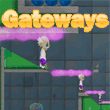Wywiad z twórcą gier Shuggy i Gateways. Jak wyglądałby Portal w 2D?
Po roku pracy w dużej firmie David Johnston stracił wiarę w przemysł rozrywki elektronicznej, ale nie przestał marzyć o tworzeniu gier. Producent ze studia Smudged Cat Games wypuścił w tym miesiącu dwa tytuły – pecetową wersję Adventures of Shuggy oraz nową rzecz: Gateways. Pierwsza z nich to radosna i zaskakująco dobra platformowka. Druga jest próbą odpowiedzenia na powyższe pytanie: jak Portal wyglądałby w dwóch wymiarach?

Z tej okazji przepytałem dewelopera o jego historię, konwersję Shuggy’ego na PC i związane z nią nadzieje, oraz ulubione patenty na rozgrywkę. Dave opowiedział też o swoim nowym dziele, które pozornie przypomina grę Valve, ale wprowadza mnóstwo autorskich pomysłów. Dostajemy w niej nie jeden, a kilka „portal gunów” oraz dużą, otwartą mapę, skonstruowaną w stylu Metroidvanii. Zapytałem też o to, jak przebiega współpraca z platformą Steam.
Historia Dave’a, Smudged Cat Games i Shuggy’ego
Szymon Liebert: Wiem, że robisz gry od lat, aż od czasów Net Yaroze (specjalne wydanie konsoli PlayStation – przyp. Hed). Czy możesz powiedzieć coś o sobie? Czy tworzenie gier to Twoja praca?

Dave Johnston: Chciałbym, żeby to było moją pracą, ale jeszcze nie dotarłem do tego momentu! W tej chwili mam 33 lata i robiłem gry odkąd miałem jakieś 10 lat. Zacząłem od małych gier na BBC Micro – nie zrodziło się z tego nic specjalnego. Dostałem Net Yaroze kiedy byłem na uniwersytecie i wtedy zrobiłem grę Time Slip. Gracz podróżował w niej wstecz w czasie, aby odkryć swoje poprzednie wersje, których trzeba unikać. Gra została wybrana na płytkę brytyjskiego Official PlayStation Magazine, co było świetną sprawą dla mnie w tamtym okresie, bo akurat kończyłem studia i zaczynałem szukać pracy. Oznaczało to, że mogłem wziąć płytkę z PlayStation na rozmowę o pracę i pokazać grę, którą zrobiłem. Niewiele osób w moim wieku mogło pochwalić się czymś takim.
Dzięki temu dostałem pracę w Rare (studiu znanym z Goldeneye i Banjo Kazooie), która wtedy wydawała się wymarzoną posadą. Niestety, wymarzona praca nie spełniła moich oczekiwań i odszedłem ze studia po roku, rozczarowany przemysłem gier. Pracowałem później jako programista dla kilku firm nie zajmujących się grami, ale nigdy nie przestałem myśleć o tworzeniu gier. Kiedy Microsoft zapowiedział platformę XNA w 2007 roku, która dawała możliwość wypuszczenia gry na Xboksie, ucieszyłem się i postanowiłem zajmować się grą w wolnym czasie. Tak powstał Shuggy, który w 2007 roku dotarł do finałów konkursu Dream Build Play, a później został wydany jako gra Xbox LIVE Arcade.
Szymon Liebert: Porozmawiajmy najpierw o Adventures of Shuggy. Gra zadebiutowała rok temu na Xbox LIVE Arcade i zebrała wysokie oceny, ale nie została szerzej zauważona. Teraz przenosisz ją na pecety, co okazało się dobrym rozwiązaniem dla paru innych deweloperów z XBLA/Indie Channel. Jakie są Twoje oczekiwania?
Dave Johnston: Wszyscy wydają się mówić, że dzisiaj wypuszczenie gry na Steamie jest dobrą drogą dla niezależnych deweloperów, więc mam skromną nadzieję, że sprawy potoczą się lepiej tym razem. Oczywiście wydawało mi się, że wypuszczenie gry na XBLA jest genialnym pomysłem, więc staram się nie pokładać zbyt wiele nadziei w ten projekt, bo sam doskonale wiem, jak takie rzeczy mogą się skończyć!
Naprawdę szkoda, że niewiele osób odkryło grę na Xboksie. Odzew, jaki otrzymałem od ludzi, którzy zagrali w grę był naprawdę pozytywny i, tak jak mówisz, prasa także ją polubiła. A jednak jakoś opinia, że to zabawna gra nie zaczęła krążyć wśród społeczności XBLA.
Adventures of Shuggy na PC
Szymon Liebert: Zrezygnowałeś z trybu współzawodnictwa w pecetowej wersji Adventures of Shuggy. Czy są jakieś inne zmiany, ulepszenia lub dodatki?
Dave Johnston: Tak, szkoda, że musiałem odrzucić to z wersji pecetowej. Firma PomPom Games pomagała przy wydaniu gry na XBLA z obsługą online, bo to bardziej skomplikowana rzecz od zrobienia gry solowej. Zamiast poświęcać czas i pieniądze na implementowanie funkcji w wersji pecetowej, postanowiłem zrezygnować z tego elementu i zostawić sobie możliwość dodania go z powrotem, jeśli gra sprzeda się dobrze i będę mógł sfinansować pracę nad nim.
Szczerze mówiąc, tak naprawdę nigdy nie lubiłem trybu współzawodnictwa i nie uważam go za szczególnie udany. Myślę, że Shuggy działa najlepiej jako gra solowa lub kooperacyjna. Wolałbym na przykład zaimplementować nowe poziomy do gry zanim zająłbym się przywróceniem trybu rywalizacji, bo myślę, że to bardziej by ją wzbogaciłoby.

Poza tym nie ma żadnych dużych zmian. Podrasowałem nieco niektóre poziomy, ale to dotyczy detali, których raczej nikt nie zauważy. Shuggy na XBLA był dość popularny wśród członków społeczności speed runningowej, więc wprowadziłem parę zmian w oparciu o ich uwagi. Niektórzy przeciwnicy cechowali się dużą przypadkowością. Mówiąc konkretniej, komary w grze mogą być nieprzewidywalne, bo mają wyjątkowo nieregularne wzory latania. To oznacza, że jeśli próbujesz przejść poziom w określonym czasie nie możesz przewidzieć, gdzie będzie komar, bo za każdym razem leci on gdzie indziej. Teraz wydaje się, że przeciwnicy nadal poruszają się w losowy sposób, ale tak naprawdę po każdym restarcie poziomu podążają po dokładnie takich samych ścieżkach, więc można zaplanować sobie najszybszą trasę przez etap.
Szymon Liebert: W Shuggy użyłeś wielu pomysłów na rozgrywkę – zabawy czasem, grawitacją, hakiem z liną, itd. Z czego jesteś najbardziej dumny i co najbardziej lubisz w grze?
Dave Johnston: Dla większości ludzi najbardziej wyróżniają się chyba poziomy z podróżami w czasie, ale mówiąc szczerze, implementowałem je w paru grach i teraz powoli ten pomysł zaczyna mi się nudzić. Bardzo lubię grać w niektóre z poziomów z obszaru cmentarza, gdzie zmienia się mechanika skakania. Możesz zarówno robić wysokie, dryfujące skoki, jak i opadać powoli. Są też poziomy, w których w ogóle nie musisz dotykać ziemi, żeby skakać.

Moją ulubioną mechaniką rozgrywki jest prawdopodobnie huśtanie się na linie. Bardzo podoba mi się to, że możesz owinąć ją dokoła poziomu i huśtać się w ten sposób. Kiedy dodałem taki element rozgrywki pomyślałem, że to naprawdę fajny pomysł, który do dzisiaj wywołuje mój uśmiech podczas gry.
Gateways: „jak wyglądałbym Portal w 2D?”
Szymon Liebert: Przejdźmy do Twojej nowej gry &‐ Gateways. Wygląda ona na połączenie paru innych gier i w pewien sposób kontynuację Shuggy’ego. Co dodajesz do tej rozgrywki inspirowanej Portalem?

Dave Johnston: Tak, oczywistym por&´wnaniem dla Gateways zawsze będzie Portal! Sam fakt, że Gateways jest w 2D czyni jednak z niego całkiem inną grę. Zaczęło się od tego, że zastanawiałem się jak Portal mógłby wyglądać w dwóch wymiarach. Uwielbiam to, że portale w Portal są „połączone”. Było mnóstwo gier z podobnym rozwiązaniem, gdzie teleportowałeś się po wejściu do czegoś, ale dopiero fakt, że możesz najpierw spojrzeć przez portale i dopiero potem przejść przez nie stanowi niezwykłość Portala, którą chciałem uchwycić. To doprowadziło mnie do widoku, którego używam Gateways i który pozwala oglądać to, co jest po drugiej stronie „bramy” na podstawie pozycji gracza. Dzięki temu przejście przez nią jest wizualnie płynne i nie sprawia wrażenia prostego teleportowania się pomiędzy punktami mapy.
Kiedy miałem już zaimplementowaną tę funkcję, zacząłem zastanawiać się, co jeszcze można zrobić z portalami. Zdałem sobie sprawę, że jeśli dwie połączone ze sobą bramy będą miały różne rozmiary, to świat wydawałby się mniejszy, kiedy patrzysz przez jedną z nich i większy, gdy patrzysz przez drugą. Z tego wynika następny krok – kiedy wejdziesz przez jedną bramę stajesz się większy, a przez drugą – malejesz. Inny pomysł wiąże się z tym, że kiedy wejdziesz przez bramę połączoną z drugą znajdującą się na suficie, wypadasz przez nią z góry. Zadałem sobie pytanie: „a co gdyby świat pozostał taki sam jak to, co widzisz po drugiej stronie portalu?”. Przejście przez niego oznaczało, że po prostu wchodzisz na ścianę, a grawitacja dostosowuje się do tego, co widziałeś wcześniej! Ostatecznie, mając na uwadze moje przeszłe doświadczenia z grami o podróżach w czasie musiałem zainteresować się tym, jak wyglądałby ten element w przypadku portali. W pierwszej chwili wydawało się, że to nie będzie działać. Potem zdałem sobie sprawę, że po wprowadzeniu paru ograniczeń – uniemożliwiających przesuwanie bram po ich wykorzystaniu – pomysł sprawdza się naprawdę dobrze i może przekładać się na interesującą rozgrywkę.
Szymon Liebert: Interesującą kwestią jest sama mapa – to jeden obszerny poziom. Czy możesz powiedzieć jak duża jest gra?
Dave Johnston: To kolejna rzecz, która odróżnia Gateways od Portala. Podczas gdy Portal to seria poziomów, Gateways stawia na podejście w stylu Metroidvanii, w którym po prostu włóczysz się po całkowicie otwartym świecie, z czasem odblokowując więcej stref dzięki nowym mocom.
Szacowałbym, że przejście gry zajmie przeciętnemu graczowi około 6-8 godzin. Na mapie jest poukrywanych 30 ulepszeń, ale nie wszystkie z nich są potrzebne do ukończenia rozgrywki. Nie zamierzałem tworzyć gry, której ukończenie zajmowałoby wieczność. Mapa jest dość gęsto obsadzona różnymi łamigłówkami, które mają na celu zminimalizowanie backtrackingu (wracania do tych samych miejsc – przyp. Hed). Moim celem było stworzenie gry, która jest zabawia i stanowi wyzwanie – możesz ją ściągnąć i przejść w weekend bez żadnych dłużyzn. Dostajesz same interesujące zagadki.
Szymon Liebert: Pierwsze łamigłówki w Gateways są dość proste. Jak to zmienia się w dalszej części gry?
Dave Johnston: Mogę zapewnić, że zdecydowanie stają się bardziej skomplikowane! Gracz zaczyna tylko z możliwością poruszania się i skakania, ale szybko dostaje pierwsze „działo bramowe”. Później zdobywasz oczywiście inne wersje tej broni, które omówiłem wcześniej i parę przedmiotów wykorzystywanych w zagadkach. Na przykład lustro, którym możesz odbić promień lasera lub latarkę pomagającą w ciemniejszych rejonach piwnicy i aktywującą przełączniki czułe na światło. W większości przypadków możesz i tak używać tylko jednego rodzaju portalów, co ogranicza złożoność gry. Mogę jednak potwierdzić, że pod koniec otrzymujesz zdolność używania wszystkich działek w jednym momencie, co prowadzi do naprawdę wykręconych łamigłówek.

Jedną z moich trosk dotyczyła upewnienia się, że ludzie nie utkną w grze. Wiem jak bardzo może frustrować nagłe zatrzymanie się na czymś i brak pomysłów na to, jak kontynuować rozgrywkę. Jako, że świat gry ma otwartą strukturę, mapa wskazuje miejsca zawierające łamigłówki, których jeszcze nie rozwiązałeś i pokazuje, gdzie znajduje się kolejny cel główny. Obok każdej zagadki (oprócz ostatniej!) znajduje się też punkt pomocowy, w którym można wykorzystać kule mocy zbierane podczas gry. Za 15 kul możesz odkryć, czy poradzisz sobie z danym wyzwaniem przy pomocy sprzętu, który masz. To Metroidvania, więc często trafiasz na przeciwności, z którymi w danym momencie gry nie możesz sobie poradzić, bo nie masz odpowiednich ulepszeń. Kiedy dana łamigłówka jest rozwiązywalna, możesz wydać kolejne 35 kul mocy, a gra po prostu rozwiąże ją za ciebie!
Szymon Liebert: Jakiś czas temu odbyła się beta Gateways, wcześniej wypuściłeś demo. Jakiego rodzaju odzewu oczekujesz od graczy testujących te wersje?
Dave Johnston: Dostałem kilka doniesień o błędach w grze, co jest niezwykle użyteczne i jestem wdzięczny osobom, które je zgłaszają. Cieszę się z wszelkiego odzewu na temat gry, błędów, czy zmian, jakie można wprowadzić lub po prostu tego, że ktoś bawił się przy niej dobrze! Nie planowałem żadnych drastycznych zmian pomiędzy wersją beta a finalnym wydaniem... Nie zamierzam też dodawać pistoletu, żeby ludzie mogli wystrzelać sobie drogę przez laboratorium, ale zawsze jest szansa na to, aby poprawić parę łamigłówek.

Szymon Liebert: Jeśli dobrze pamiętam, miałeś pewne problemy z wydawcą Shuggy’ego na Xboksie 360. Jak podoba ci się praca ze Steamem?
Dave Johnston: Było trudno dotrzeć do Valve. Zgłosiłem Shuggy’ego po raz pierwszy 25 stycznia i dopiero po kilku miesiącach otrzymałem ogólną odpowiedź, że chcieliby zobaczyć grę na Steamie. Zgaduję, że oni są zasypywani podobnymi zgłoszeniami i musi być trudno przedrzeć się przez to wszystko i wybrać dobre rzeczy. Słyszałem, że Valve nie ma aż tak wielu ludzi w zespole w stosunku do tego, ile zgłoszeń otrzymują. Z jednej strony jest to zrozumiałe, ale mimo wszystko konieczność czekania tak długo na odpowiedź może być frustrująca dla dewelopera. Odkąd Shuggy został zaakceptowany, mam lepszy kontakt z nimi, co ułatwia wiele rzeczy.
Zainteresowanych pracą Smudged Cat Games odsyłam do recenzji Adventures of Shuggy (film z gry jest na moim kanale YouTube, inny film zrobiłem dla tvgry.pl). O Gateways wspominałem z okazji wypuszczenia dema (dostępnego na stronie dewelopera, polecam). Obie gry znalazły się też w przeglądzie Prosto z Indie, który prowadzę na gry-online.pl.
Adventures of Shuggy kosztuje 6,99 euro na Steamie. Gateways można kupić na stronie twórcy za 10 dolarów. W najbliższych dniach powinna pojawić się wersja steamowa.
Interview with Dave Johnston from Smudged Cat Games (english version)
Szymon Liebert: I know you’ve been making games for years now, going back to Net Yaroze. Could you tell more about yourself? Is designing games your full time job?
Dave Johnston: I’d like it to be my full time job but I’m not quite there yet! I’m 33 now and I’ve been making games on and off since I was probably about 10. I started making little games on the BBC Micro but nothing special. I got a Net Yaroze when I was at university and made a game called Time Slip where the player travelled back in time continually to encounter past versions of themselves that they had to avoid. It got picked to appear on the cover disk of the Official Playstation UK magazine which was brilliant for me at the time as I was graduating and starting to look for a job. It meant I could take an actual Playstation disk into a job interview and show then a game I’d made, not something many other people my age could do at the time.
It got me a job at Rare (of Goldeneye and Banjo Kazooie fame) which was my ideal job at the time. Unfortunately my ideal job didn’t quite live up to expectations and I left after just a year, disillusioned with the game industry. I went to work for a couple of non-games companies as a software engineer but could never quite stop thinking about game development. When Microsoft announced the XNA framework in 2007 with the possibility of releasing games for the XBox I got excited and decided to start working on a game in my spare time. That game went on to become Shuggy, was listed as a finalist in the 2007 Dream Build Play competition and eventually got released as an XBLA game.
Szymon Liebert: Let’s talk about The Adventures of Shuggy first. The game was released a year ago for the Xbox LIVE Arcade and got pretty good scores but went fairly unnoticed. Now you’re going for the PC, which turned out good for a few XBLA/Indie developers. What are your personal expectations?
Dave Johnston: Everyone seems to say that releasing through Steam is the way to go for indie developers these days so I’m quietly optimistic that things might turn out better this time around. Of course, I thought that releasing a game on XBLA would work out really well so I’m trying not to pin too much hope on it as I know only too well how these things can turn out!
It’s feels like such a shame that not that many people got to discover the game on the XBox. Any feedback I’ve had about people playing the game has been really positive and, like you say, the press seemed to like the game. The word just never really seemed to get around in the XBLA community that it was a fun game.
Szymon Liebert: So, you’ve dropped online head-to-head mode in the PC release. Are there any other changes, upgrades or additions?
Dave Johnston: Yeah, it’s a shame I’ve had to drop that from the PC release. PomPom games actually worked with me on the XBLA version to provide the online support as it can prove more complicated than just making a single player game. Rather than spending the time or money implementing it in the PC version I decided it was best to leave it out for now and possibly add it back in if the game sells well and I can fund the development of it. To be honest, I never really liked the head-to-head mode anyway, I don’t think it works particularly well. I think Shuggy works best as a single player or co-op game. I’d actually be more keen to implement new levels for the game before I return to re-implement the head-to-head mode as I think that would add more value to the game.
There haven’t been any other major changes to the game. I’ve tweaked some of the levels a little bit but nothing that anyone is particularly likely to notice. Shuggy on XBLA seemed to be popular with the speed running community and I’ve made a few changes based on their feedback. Some enemies have an element of randomness to them. In particular, the mozzies in the game can be particularly unpredictable as they have quite erratic flying patterns. It meant if you were trying to complete a level in a certain time you couldn’t rely on where a mozzy would be, it would be different every time. Now the enemies still appear to move randomly but they actually move in exactly the same way every time you restart the level making it possible to plan the fastest route through the level.
Szymon Liebert: In Shuggy you have a lot different gameplay ideas – stuff with time, gravitation, grappling hook, and so on. What are you most proud of or what do you like the most in the game?
Dave Johnston: For most people the time travel levels probably stand out most in the game but, to be honest, I’ve implemented time travel in several games now and it’s starting to be a bit too familiar to me. I really enjoy playing some of the levels in the graveyard area of the game where the jump mechanic gets changed. You can either do a really high floaty jump and stop yourself falling on the way down or there are levels where you don’t need to be on the ground at all to jump.
Probably my favourite gameplay mechanic is the rope swinging stuff. I really like the way you can wrap the rope around the level and then start swinging from it. When I added the ability to wrap the rope around cog so you can turn it I thought it was really neat idea which still makes me smile when I play the game today.
Szymon Liebert: Let’s move on to your new game - Gateways. It looks like a combination of different games and a follow-up to Shuggy. What are you adding to this Portal-inspired gameplay?
Dave Johnston: Yes, the obvious comparison to Gateways is always going to be Portal! Just the fact that Gateways is in 2D does make it quite a different game though. It first came about as I was thinking how Portal might work in 2D. I loved the way the portals in Portal just ‘connected’, plenty of games had similar things where you teleported as you walk into something but the fact you could look through the portals and then just walk through is what makes Portal special so I wanted to replicate that. It led me to the view that’s used in Gateways now where you can see through a gateway based on the player’s relative position to it. It means that walking through a gateway is visually seamless and it doesn’t seem like your teleporting across the map.
Once I had that implemented I started thinking about what else you could do with them. It occurred to me that if two connected gateways were different sizes but still connected up to each other then the world would seem smaller looking through one and bigger looking through the other. From there it naturally occurs that walking through one makes you grow big and the other makes you shrink small. Another idea came from the fact that walking through a gateway on the wall connected to one on the ceiling means that you fall out of the one of the ceiling. I just asked myself “what if the world stayed exactly the same as you see it on the other side of the gateway?”. Walking through meant that you actually just walked on the wall and gravity changed reflect the view through the gateway! Finally, it was inevitable based on my past experience with time travel games that I would ponder how a time travelling gateway would work. At first I didn’t really think it would work properly but then I realised that with a few restrictions like not being able to move the gateways once they were placed it actually worked really well and made for some interesting gameplay!
Szymon Liebert: The interesting idea here is the map itself – it’s just one large level. Is it possible to say how big is this game content-wise?
Dave Johnston: It’s another thing that differentiates Gateways from Portal. Whereas Portal was a series of levels Gateways takes a Metroidvania approach and lets you wander around a completely open world, gradually unlocking more as you acquire each power up.
I’d say the game probably takes most people about 6-8 hours to complete, there are around 30 power ups dotted around the map that you can find, although not all of them are essential to completing the game. I wasn’t setting out to create a game that’ll take people forever to complete. The map is fairly densely populated with the different puzzles to minimize the amount of backtracking people have to do. My aim was to create a game that is fun and challenging that you can download and play through over a weekend with no filler, just interesting puzzles.
Szymon Liebert: The first puzzles in Gateways are straightforward. How does it change later on the game?
Dave Johnston: I can say that they definitely get more complicated! Players start out the game just able to move and jump but very quickly get the first gateway gun. After that they obviously acquire the different guns that I’ve just talked about and a couple of other items used for puzzles. The mirror which you can use to deflect laser beams and the torch which helps you see in the darker basement area of the game and activate light sensitive switches. For the majority of the game you can only use one gateway gun at a time which limits the complexity but I can confirm that near the end of the game you gain the ability to use all guns at the same time which leads to some truly mind-bending puzzles.
One of my concerns was actually making sure that people didn’t get stuck in the game. I know how frustrating it can be to be playing a game but then get completely stumped and unable to progress any further. Due to the open-world nature of the game there is a map which highlights where there are different puzzles you haven’t solved yet and also tells you where your next main objective is. There is a help point beside every puzzle in the game (except the last one actually!) where you can spend power orbs, the collectables in the game. For 15 orbs you can find out if you can actually solve the puzzle using the power ups that you already have, you encounter numerous puzzles before you actually have the power ups to solve them in true Metroidvania style. Once the puzzle is solvable you can spend a further 35 orbs and the game will actually just solve the puzzle for you!
Szymon Liebert: Recently we got Gateways beta, earlier you've released a demo. What kind of feedback are you expecting from the players testing it?
Dave Johnston: I’ve been getting a few bug reports in about the game which is really useful and I’m very grateful to those people. I’m happy to hear any feedback about the game really, bugs, changes people think could be made or just that someone enjoyed it! I’m not planning on making any drastic changes to the game between now and the release,... I’m not going to be adding a gun so that people can blast their way through the lab but there’s still scope to change some of the puzzles around a bit.
Szymon Liebert: If I remember correctly, you’ve had some problems with the publisher of Shuggy on Xbox 360. How do you like working with Steam now?
Dave Johnston: It’s been difficult getting through to Valve at times. I originally submitted Shuggy on the 25th of January and it took them several months to actually respond and say they’d like the game on Steam. I guess they get so swamped with submissions that it must be hard to sift through everything and pick out the good stuff. I’ve heard they don’t have that many people working on the team given the number of submissions they receive so I guess it’s understandable but it’s still frustrating as a developer to be spending so much time waiting on a response from them. Now that Shuggy has been accepted I’ve got much more regular contact with them which makes things a lot easier.
więcej na temat
- Folklands
- Legends BMX
- Caligo
- Morkull Ragast's Rage
- Only Way is Down
- Miryam: The Polluted Land
- MeMic
- OUTLAWED
- Rogue: Genesia
- Moorhuhn Kart 4
Opisywane gry
 Gateways
Gateways The Adventures of Shuggy
The Adventures of ShuggyPopularne na blogu gry same się nie przejdą!
- Próba ustanowienia Światowego Rekordu Guinnessa w Kinect Sports już w sobotę!
- Gabriel z Castlevania: Lords of Shadow ruszy na kolejną wyprawę w tym miesiącu
- Oryginalnie i urokliwie – gra Bastion nadchodzi
- Bolidy i hatchbacki w listopadowym dodatku do Forza Motorsport 4
- Nowe obrazki z Crimson Alliance
- Nowe funkcje w Halo Waypoint i animowany komiks ze świata gry
Najnowsze na blogu gry same się nie przejdą!
- Sympatyczni i niepotrzebni – recenzja filmu Ratchet i Clank
- Dark Souls III ma w sobie nowy ogień – nowa nadzieja po becie multiplayer
- Broforce – Robocop, Rambo i Ripley w browurowej grze – test wersji alfa
- Karol i Witek przegrali „Powstanie Warszawskie” – recenzja filmu
- Pixel Piracy - piracić czy nie piracić? – test wersji alfa
- Kiedy Xbox One wyjdzie w Polsce? Czy wystarczy PS4 na polską premierę? – plotki z branży
